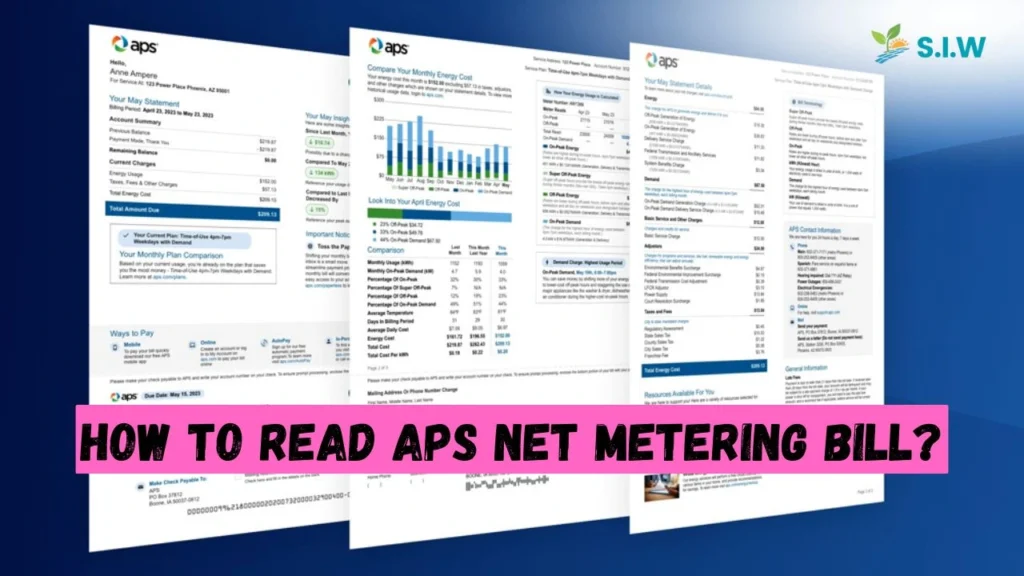Understanding your APS (Arizona Public Service) net metering bill is crucial to accurately assess your energy production, usage, and billing details. With net metering, you can track how much energy you produce versus consume, and monitor your savings from solar power. This guide breaks down each section of your APS net metering bill for a clearer understanding of the terms, charges, and credits involved.
What Is Net Metering?
Net metering allows solar energy system owners to send any excess electricity generated back to the grid, receiving credits on their energy bill. This system enables you to only pay for the “net” electricity usage—the difference between the electricity you consume from the grid and what your solar panels generate. APS’s net metering policy applies a one-to-one credit for kilowatt-hours (kWh) sent back to the grid, although this credit may vary depending on the time of use.
Key Sections of the APS Net Metering Bill
Each section of your APS bill provides valuable information, from billing details to your net metering summary. Here’s a breakdown:
1. Account Summary
- Current Charges: Displays the total amount due for the billing period, including energy consumption, demand charges, and additional fees.
- Billing Period: Shows the dates for which charges apply, usually covering one month.
- Previous Balance and Payments: Lists any previous unpaid balance and payments made during the last billing cycle.
2. Energy Usage Summary
- Total kWh Used: The total energy used from the grid during the billing period.
- Total kWh Generated: Shows how much energy your solar panels produced.
- Net Energy: Reflects the balance of energy drawn from the grid versus the energy generated by your solar system. If you produced more energy than you used, this number should be negative, indicating a credit.
3. Billing Rate Plans
- Standard Rate: The per-kWh rate APS charges for grid energy. Rates may vary depending on your plan and time-of-use (TOU).
- Net Metering Credits: For any surplus energy sent back to the grid, APS applies a credit at an adjusted rate. This rate may differ from the purchase rate of kWh.
4. Demand Charges and Peak Demand
- Demand Charges: Certain plans include demand charges based on the maximum power used at one time. These charges cover peak usage and are calculated separately from kWh charges.
- Peak Demand Periods: Some rate plans include higher rates during peak demand periods. If you are on a time-of-use (TOU) plan, your bill will specify the times when peak rates apply.
5. Monthly Meter Reading
- Meter Reading Dates: Displays the start and end dates for your billing cycle.
- Metered kWh Consumed: Total electricity drawn from the grid for the billing cycle.
- Metered kWh Produced: Electricity generated by your solar system over the billing cycle.
- Net Metering Adjustments: Any adjustments based on your net consumption or production are reflected here.
6. Taxes, Fees, and Additional Charges
- Renewable Energy Standard Fee: A small charge supporting Arizona’s renewable energy standards.
- Environmental Program Cost: Fees covering the cost of APS’s environmental programs and initiatives.
- Sales Tax: Taxes applied to total bill amounts, varying based on your location within Arizona.
7. Net Metering Summary
- Net Excess Generation (NEG): If you generated more electricity than you consumed, the NEG reflects the surplus kWh credited to your next billing cycle.
- Carryover Credits: Credits for excess electricity from previous months are rolled over here. They are generally available to offset future bills or distributed annually based on APS’s payout schedule.
Example Bill Breakdown
Here’s a sample breakdown based on the APS net metering structure:
| Item | Description | Amount |
| Energy Charge | Standard kWh rate multiplied by usage | $75.00 |
| Net Metering Credit | Credit for surplus energy produced | -$25.00 |
| Demand Charge | Based on peak usage in kW | $20.00 |
| Renewable Energy Standard | Environmental fee | $3.00 |
| Total Due | Final amount payable after credits | $73.00 |
FAQs
What Happens If My Solar Panels Generate More Power Than I Use?
If you generate more power than you consume, APS credits your bill with the excess at a specific rate per kWh. This credit rolls over each month.
How Does APS Calculate My Demand Charge?
APS calculates demand charges based on the highest kW of power used during peak hours, depending on your rate plan.
Will I Lose My Net Metering Credits at the End of the Year?
Net metering credits typically roll over, and some rate plans include an annual payout for any accumulated excess credits.
Understanding your APS net metering bill ensures you accurately track energy usage, optimize solar benefits, and take control of your energy costs. By reviewing each section carefully, you can maximize savings and make informed energy decisions year-round.








